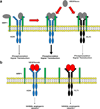VEGFA splicing: divergent isoforms regulate spermatogonial stem cell maintenance
- PMID: 26553653
- PMCID: PMC4703427
- DOI: 10.1007/s00441-015-2297-2
VEGFA splicing: divergent isoforms regulate spermatogonial stem cell maintenance
Abstract
Despite being well-known for regulating angiogenesis in both normal and tumorigenic environments, vascular endothelial growth factor A (VEGFA) has been recently implicated in male fertility, namely in the maintenance of spermatogonial stem cells (SSC). The VEGFA gene can be spliced into multiple distinct isoforms that are either angiogenic or antiangiogenic in nature. Although studies have demonstrated the alternative splicing of VEGFA, including the divergent roles of the two isoform family types, many investigations do not differentiate between them. Data concerning VEGFA in the mammalian testis are limited, but the various angiogenic isoforms appear to promote seminiferous cord formation and to form a gradient across which cells may migrate. Treatment with either antiangiogenic isoforms of VEGFA or with inhibitors to angiogenic signaling impair these processes. Serendipitously, expression of KDR, the primary receptor for both types of VEGFA isoforms, was observed on male germ cells. These findings led to further investigation of the way that VEGFA elicits avascular functions within testes. Following treatment of donor perinatal male mice with either antiangiogenic VEGFA165b or angiogenic VEGFA164 isoforms, seminiferous tubules were less colonized following transplantation with cells from VEGFA165b-treated donors. Thus, VEGFA165b and possibly other antiangiogenic isoforms of VEGFA reduce SSC number either by promoting premature differentiation, inducing cell death, or by preventing SSC formation. Thus, angiogenic isoforms of VEGFA are hypothesized to promote SSC self-renewal, and the divergent isoforms are thought to balance one another to maintain SSC homeostasis in vivo.
Keywords: Self-renewal; Spermatogonia; Testis; VEGFA164; VEGFA165b.
Figures







Similar articles
-
VEGFA family isoforms regulate spermatogonial stem cell homeostasis in vivo.Endocrinology. 2012 Feb;153(2):887-900. doi: 10.1210/en.2011-1323. Epub 2011 Dec 6. Endocrinology. 2012. PMID: 22147017 Free PMC article.
-
Neutralization of vascular endothelial growth factor antiangiogenic isoforms or administration of proangiogenic isoforms stimulates vascular development in the rat testis.Reproduction. 2010 Aug;140(2):319-29. doi: 10.1530/REP-09-0456. Epub 2010 May 10. Reproduction. 2010. PMID: 20457593 Free PMC article.
-
Vascular endothelial growth factor A: just one of multiple mechanisms for sex-specific vascular development within the testis?J Endocrinol. 2015 Nov;227(2):R31-50. doi: 10.1530/JOE-15-0342. Epub 2015 Oct 15. J Endocrinol. 2015. PMID: 26562337 Free PMC article. Review.
-
Vascular endothelial growth factor A isoforms modulate follicle development in peripubertal heifers independent of diet through diverse signal transduction pathways.Biol Reprod. 2020 Mar 13;102(3):680-692. doi: 10.1093/biolre/ioz211. Biol Reprod. 2020. PMID: 31723977
-
The balance of proangiogenic and antiangiogenic VEGFA isoforms regulate follicle development.Cell Tissue Res. 2012 Sep;349(3):635-47. doi: 10.1007/s00441-012-1330-y. Epub 2012 Feb 10. Cell Tissue Res. 2012. PMID: 22322423 Free PMC article. Review.
Cited by
-
Exogenous gonadotropin-releasing hormone counteracts the adverse effect of scrotal insulation on testicular functions in bucks.Sci Rep. 2022 May 12;12(1):7869. doi: 10.1038/s41598-022-11884-4. Sci Rep. 2022. PMID: 35551262 Free PMC article.
-
The "Hitchhiker's Guide to the Galaxy" of Endothelial Dysfunction Markers in Human Fertility.Int J Mol Sci. 2021 Mar 4;22(5):2584. doi: 10.3390/ijms22052584. Int J Mol Sci. 2021. PMID: 33806677 Free PMC article. Review.
-
Microenvironment of spermatogonial stem cells: a key factor in the regulation of spermatogenesis.Stem Cell Res Ther. 2024 Sep 11;15(1):294. doi: 10.1186/s13287-024-03893-z. Stem Cell Res Ther. 2024. PMID: 39256786 Free PMC article. Review.
-
Developmental exposure to real-life environmental chemical mixture programs a testicular dysgenesis syndrome-like phenotype in prepubertal lambs.Environ Toxicol Pharmacol. 2022 Aug;94:103913. doi: 10.1016/j.etap.2022.103913. Epub 2022 Jun 20. Environ Toxicol Pharmacol. 2022. PMID: 35738462 Free PMC article.
-
Exploration of miRNA and mRNA Profiles in Fresh and Frozen-Thawed Boar Sperm by Transcriptome and Small RNA Sequencing.Int J Mol Sci. 2019 Feb 13;20(4):802. doi: 10.3390/ijms20040802. Int J Mol Sci. 2019. PMID: 30781801 Free PMC article.
References
-
- Airaksinen MS, Saarma M. The GDNF family: signalling, biological functions and therapeutic value. Nat Rev Neurosci. 2002;3:383–394. - PubMed
-
- Altavilla D, Romeo C, Squadrito F, Marini H, Morgia G, Antonuccio P, Minutoli L. Molecular pathways involved in the early and late damage induced by testis ischemia: evidence for a rational pharmacological modulation. Curr Med Chem. 2012;19:1219–1224. - PubMed
-
- Amin EM, Oltean S, Hua J, Gammons MV, Hamdollah-Zadeh M, Welsh GI, Cheung MK, Ni L, Kase S, Rennel ES, Symonds KE, Nowak DG, Royer-Pokora B, Saleem MA, Hagiwara M, Schumacher VA, Harper SJ, Hinton DR, Bates DO, Ladomery MR. WT1 mutants reveal SRPK1 to be a downstream angiogenesis target by altering VEGF splicing. Cancer Cell. 2011;20:768–780. - PMC - PubMed
-
- Appleton BA, Wu P, Maloney J, Yin J, Liang WC, Stawicki S, Mortara K, Bowman KK, Elliott JM, Desmarais W, Bazan JF, Bagri A, Tessier-Lavigne M, Koch AW, Wu Y, Watts RJ, Wiesmann C. Structural studies of neuropilin/antibody complexes provide insights into semaphorin and VEGF binding. EMBO J. 2007;26:4902–4912. - PMC - PubMed
Publication types
MeSH terms
Substances
Grants and funding
LinkOut - more resources
Full Text Sources
Other Literature Sources

